One of Sir Graham Henry’s greatest regrets as a coach was the halftime speech he delivered to the British and Irish Lions in the second Test of the 2001 series against the Wallabies.
The Melbourne changing sheds were unusually long and narrow, and Graham felt that he struggled to get the necessary messages across to his players.
Thus, the Lions declined from a position in which they were winning 11-6, to a disastrous loss in which they conceded 29 points while scoring only a further three points themselves – final score 35-14 to Australia.
That talk was a turning point in the game and in the series as a whole, and Graham never forgot the importance of delivering clear, concise messages at the break in order to either reinforce momentum or turn the tide.
Ex-England defence coach Phil Larder learnt about the importance of meaningful preparation for the halftime talk from another super-coach, in the rival rugby code, Jack Gibson.
On one of his many educational visits to Australia as rugby league’s coaching director in the mid-80s, Phil found out about the subtly-detailed routine ‘Gibbo’ would employ to get the most out of those ten minutes in the middle of the match.
Jack was coaching Cronulla at the time, along with his (essential) sidekick, Ron Massey. Ron was “the gun on Jack’s belt” according to league great Ray Price, and he was everything Gibson was not – calm, easy-going, genial and approachable to the players.
Jack and Ron would watch the game from their ‘eyrie’ – the highest point in the ground, the old press box – which afforded a chess-like, panoramic view of proceedings.
Ron, who according to Larder was an analytical genius who could see patterns in a game developing well before they produced concrete outcomes on the field, would jot down notes and give them to Jack.
Jack kept a small alarm-clock at his side during matches, which was timed to go off exactly eight minutes before the first half ended. That would give just enough time for any of Jack’s legendary fits of temper, which could blow up as quickly and shockingly as a bushfire, to subside.
The Craven As, which Jack chain-smoked down to the last layer of the butt, were discarded and a wad of chewing-gum would take away the stink of tobacco.
Armed with Ron’s lucid analysis ‘from above’ and protected from himself by his own well-grooved routine, Jack would enter the sheds relaxed and able to transmit three clear, tactical points for the second period to his players.
Nobody would have been able to guess the anguish suffered to get to that point, or the dependence The Supercoach had on his friend and colleague – a relationship so close that when Jack was prevented from seeing Ron when he was seriously ill in hospital (“Only close relatives and family allowed”) he simply replied, “I am family.”
[latest_videos_strip category=”rugby” name=”Rugby”]
I don’t know what Michael Cheika or his coaches said to the Wallabies at the break in Brisbane against the All Blacks, but the impact was game-changing. I suspect that the talk concentrated on Australia’s failures in contact, and specifically at the breakdown.
In the first period, the Wallabies gave up three turnovers at the ruck in 42 breakdowns, and a further three turnovers (two of which Sonny Bill Williams ‘rips’ in the tackle) in collisions. Losing one ball in seven you take into contact is definitely not a recipe to win an international rugby match!
New Zealand scored all of their 13 points from those turnovers and created another clear scoring opportunity when Williams took the ball off Tevita Kuridrani inside the Australian 22 in the 28th minute.
With Cheika’s words ringing in their ears, the Australians did not give up another turnover at the breakdown until the 65th minute, only surrendering three in the 72 second-half rucks they built, and effectively halving the total of turnovers in contact or collision from the first 40 minutes.
The Wallabies finally had some control of the ball and it enabled them to turn a 13-12 deficit into a winning 20-13 lead by the final quarter.
Since long before Cheika’s tenure, the Kiwis have focused on attacking the Australian breakdown structure. They announced their intentions in Brisbane at the very first ruck of the game:
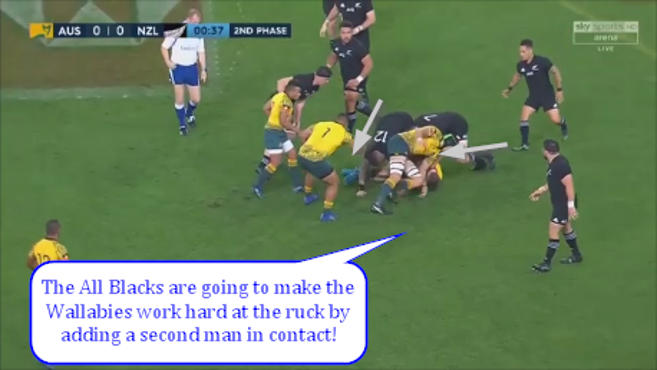
Instead of the typical ‘plus one’, the All Blacks committed a second body at the breakdown, with both Sam Cane and Williams competing over the ball.
This meant Australia, who would normally commit only two cleanout players at the tackle, had to be extremely accurate, as a higher proportion of their cleanouts were one-versus-one:

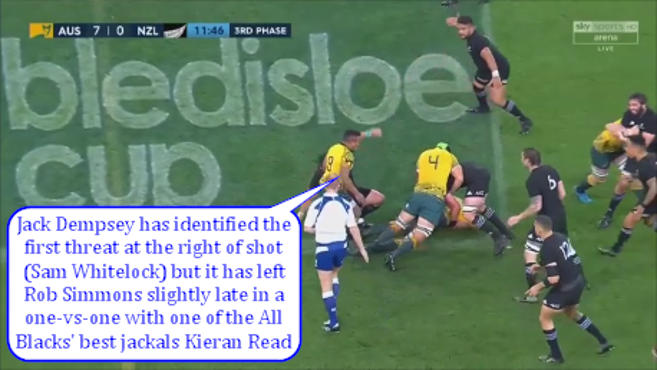
Here is a seminal example. Jack Dempsey had to take out Sam Whitelock, leaving Rob Simmons one-on-one with Kieran Read. Simmons was slightly late to the cleanout and Read won the turnover penalty. New Zealand held on to the resulting position long enough to score their first try of the game. Seven points.
On the next occasion, the ‘old firm’ of Cane and Williams descended on the tackle ball to win the turnover penalty:
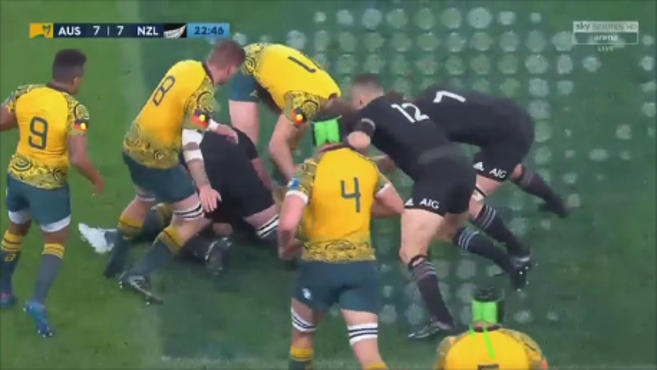
They matched up on Reece Hodge and Sean McMahon and won their battles, with Lima Sopoaga kicking the penalty. Ten points.
New Zealand constantly found ways to get their key operators at the defensive tackle – Cane, Read, Williams and Waisake Naholo – into the action and double the Aussies’ workload at breakdown time:
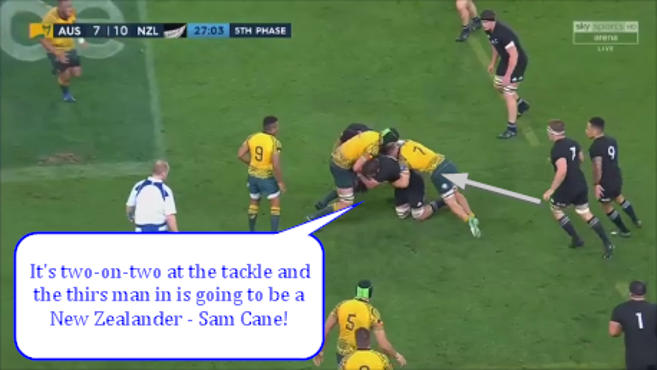
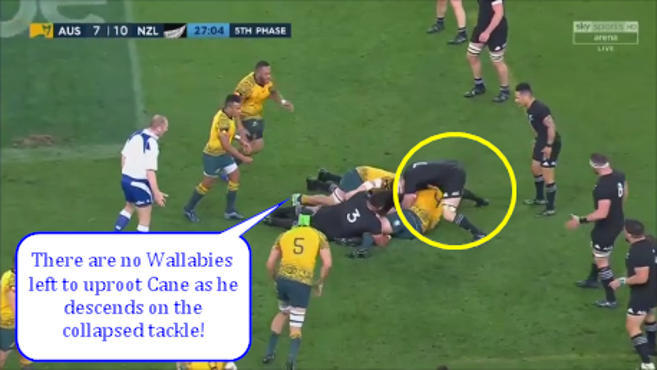
Nepo Laulala and Whitelock made the double tackle on Simmons and the first Australian to arrive, Michael Hooper, only caught a small piece of Whitelock as he entered the contact zone.
The player closest to the ball on his feet was All Blacks’ #7 Cane, who arrived unchallenged to win possession at the collapsed tackle.
The Wallabies came out in the second half having correctly identified the wrongs of the first period, and in a determined mood to put them right:
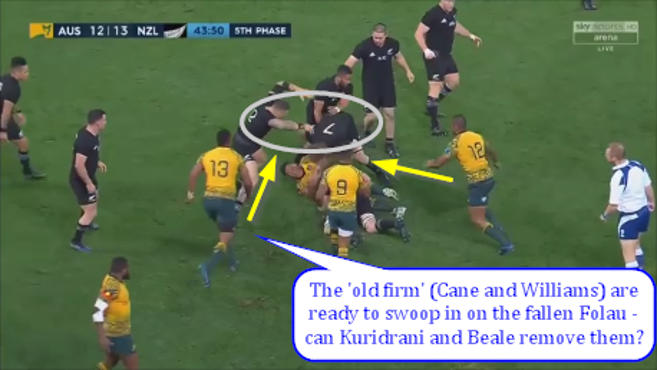
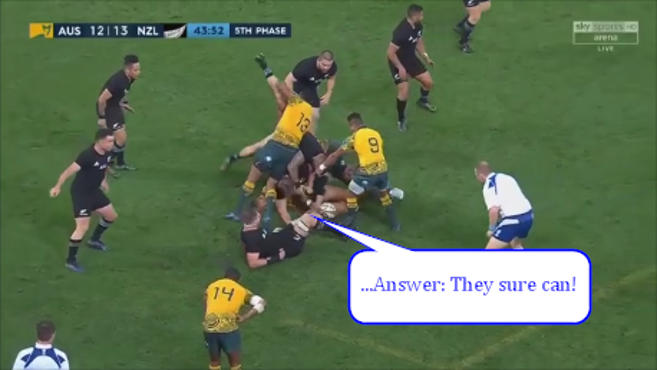
This was just as definitive a statement of intent at the start of the second half as that made by the All Blacks at the beginning of the first, with Kuridrani and Kurtley Beale winning the two-on-two battle against Cane and Williams.
However, the critical difference was Australia’s readiness to commit a third body in contact, ensuring the ruck battle was won on their terms.
More often than not, that third body turned out to be McMahon, who seemed to have special license to blast away any New Zealand ‘vultures’ waiting to pick over the bones of a Wallaby breakdown!
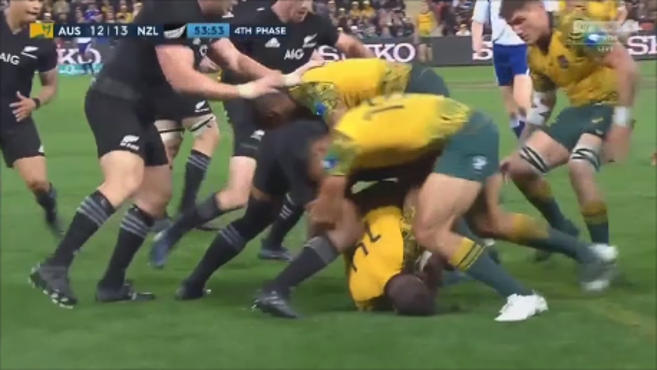
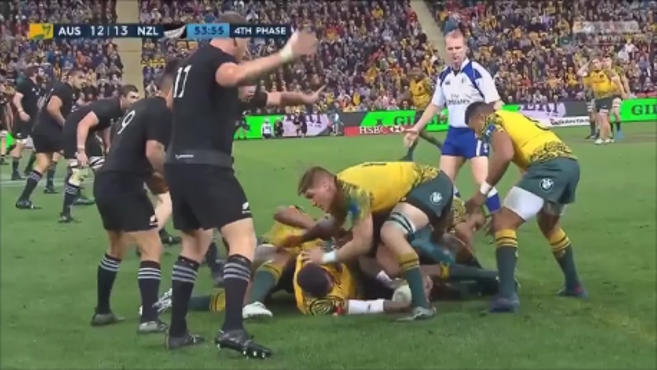
Naholo is over the ball while Cane and Wyatt Crockett are hovering, but McMahon is ready to enter the fray as the third body on the Australian side.
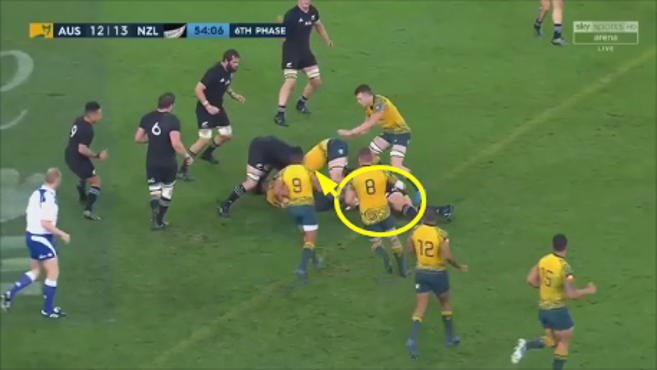

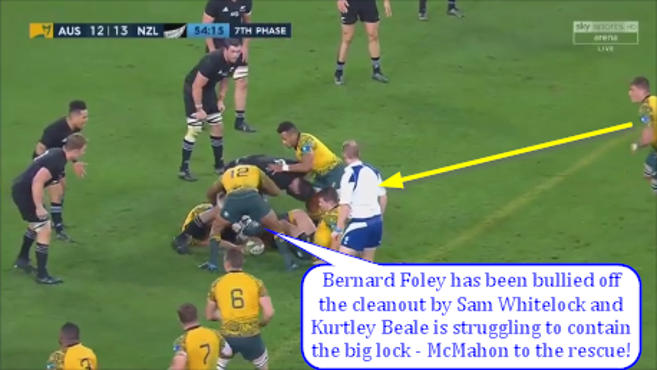
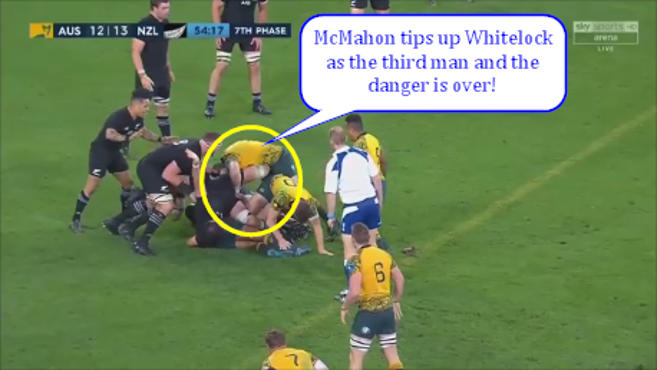
With Hooper struggling to uproot Read in the first frame, McMahon arrives as the third man (after Dempsey) to remove the threat. With two of the smaller Aussie backs (Bernard Foley and Beale) struggling to contain big Sam Whitelock in the second instance, who d’ya call? Sean McMahon, that’s who!
The ‘golden period’ in Australian breakdown fortunes lasted until 15 minutes before the end of the match. With McMahon having to play a full 80 minutes and Ned Hanigan replacing Dempsey on one flank, some of the old bad habits resurfaced and that gave the All Blacks renewed hope.
Right at the end of the game, with the Wallabies looking to run out the clock, Hanigan again got caught in a poor position at breakdown time, was rolled off the ball and penalised, giving New Zealand one last scoring chance.
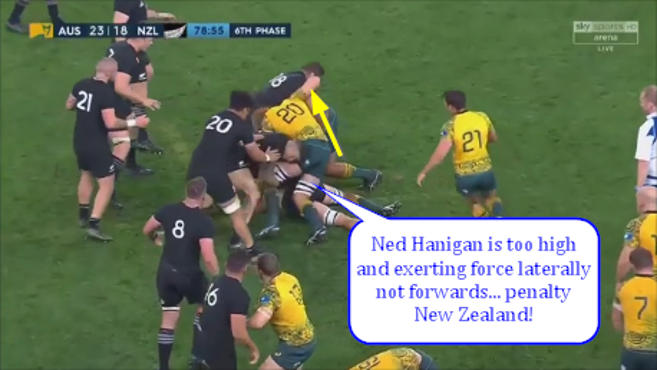
Identifying and delivering the right messages at halftime is a crucial aspect of the coach’s job. The head coach has to point out two or three areas to the players dispassionately, so that they can implement his instructions in the heat of battle. If he’s agitated or the message isn’t absolutely clear, his words will fall on stony ground.
Michael Cheika has not always shown a cool head in the coaching booth, but on this occasion the right message was without doubt delivered, and in such a way that the players could act on it in the second period.
The Australian coach identified the correct area for improvement in treacherous playing conditions. A third man was added to breakdowns whenever a threat presented itself after the tackle, and that man was usually Sean McMahon, who is rapidly becoming an indispensable cog in the machine Cheika is building.
That adjustment enabled Australia to control the ball better and edge their way out to a winning lead in the third quarter.
Coaching improvement and player improvement usually go hand in hand, and it was encouraging to see another piece of the puzzle falling into place from the coaching side of the equation at Brisbane.












































































































